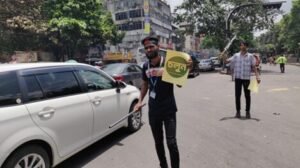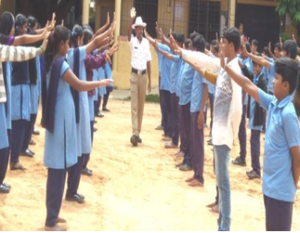Traffic congestion is a global problem, with the situation being particularly grim in urban areas of developing countries. While technology-driven solutions are expensive and often inaccessible in developing countries, student traffic volunteers are an innovative and cost-effective alternative. This blog discusses how structured student volunteer programs can revolutionize urban traffic management by drawing on successful case studies and practical strategies.
Why Student Volunteers for Traffic Management?
Volunteering is defined as an organized service aimed at helping individuals and social groups in need, characterized by selflessness and regularity (Przygoda, 2023). It is a manifestation of charity and voluntary service, reflecting the socially significant activities of individuals and groups (Ljupcho et al., 2022). In many countries in the world, volunteerism is well established. For example, countries like the USA, UK, Germany, etc. have diverse models of volunteerism, from community service to corporate volunteering (Ljupcho et al., 2022). Considering its importance in Europe, the Government integrates volunteering into national policies. Voluntary work is important for students because it can lead to personal growth, community awareness, networking, skill development, and even lead to employment opportunities (Carandang, 2015). However, in developing countries like Bangladesh, this concept is still not widely popular. Also, there is no policy from the Government level to support volunteerism (Huda, 2024).
Volunteering with traffic police, particularly through roles such as traffic control volunteer and road safety volunteer, plays a significant role in enhancing public safety and managing traffic flow. Implementing volunteers along with formal traffic police can be a very efficient way to manage traffic on roads. In another instance, Crawford (2006) and Garland (1996) mentioned that police cannot and should not have full responsibility for policing. Crawford (2006) and Garland (1996) emphasized the community and individuals are required to accept increasing levels of responsibility with police for their safety. To realize the importance of engaging volunteers along with the police, the UK government changed the legislation in 2011 named the Police Reform and Social Responsibility Act to encourage the involvement of the wider local community (HM Government, 2018)
Volunteers engaged in traffic can achieve different skills such as communication, coordination, problem-solving, leadership, and time management. Therefore, deploying student volunteers for traffic management is advantageous from both traffic management and volunteers’ viewpoints. Many volunteers engage in volunteering are driven by a strong sense of purpose and a commitment to helping others(Hasyim and Romadhona, 2022; Shamoa-Nir, 2023). Student traffic volunteers would be motivated by a desire to improve road conditions and assist their communities, particularly in alleviating traffic congestion and ensuring road safety. By working on this critical issue, they would get a sense of satisfaction.
The Building Blocks of a Successful Student Traffic Volunteer Program
- Comprehensive Training and Skill Development
To equip the students with the real-time challenge of traffic:
Theory: Basics of traffic rules, safety protocols, and conflict resolution.
Practical Training: Fieldwork at major intersections and pedestrian crossings under expert supervision.
Resilience Building: Strategies to manage stress and conflict during peak hours.
- Ensuring Safety
Safety aspects are one of the most crucial concerns for not sending students for volunteer service work. Equipping them with:
Reflective vests, helmets, and whistles for high visibility.
Operating protocols that spell out the course of action in case of any eventualities.
Supervision by senior traffic police officers ensures their safety.
- Impact Measurement
The sustainability of such initiatives must be measured to ensure continuity:
Manual Traffic Counts: The students count the flow of vehicles and waiting time.
Digital Tools: Utilizing applications like Google Maps, along with video analysis on smartphones.
Community Feedback: Conducting surveys to determine general satisfaction.
- Flexible Scheduling
Meeting the need to balance academic responsibilities for volunteering:
Shift-Based Assignments: Morning and evening slots
Recognition: Certificates of service, service-learning credit, stipends
- Public Awareness
The success would depend on gaining public acceptance and cooperation:
Public awareness should be created through media and social events.
Success stories, if any, can also be highlighted to gain credibility and acceptance.
Challenges and Solutions
While impactful, student traffic volunteer programs have to grapple with certain drawbacks such as commuter resistance, logistical challenges, and high volunteer turnover rates. Addressing these requires the following:
Community Education: Shifting the paradigm in people’s thinking of the use of students as crossing guards through an outreach program
Digital Tools: Utilizing apps such as Time Counts to organize scheduling and communications
Recognition: Volunteers get a chance to receive their due in public
Success Stories: Global Insights
Singapore: The Road Safety Champions program empowers volunteers with advocacy tools and training, fostering a culture of road safety (Singapore Police Force, 2023).
Bangladesh (2018, 2024): Student volunteers managed Dhaka’s notorious traffic during crises, showcasing their potential to handle civic responsibilities effectively (Huda, 2024).


Source: (Shuvo, 2024) Source: (Union of Catholic Asian News, 2024)
India (Bengaluru): Structured programs like SARs and TWO integrate students into traffic management, achieving significant congestion relief (Bengaluru Traffic Police, 2017).

 Source: (Bengaluru Traffic Police, 2017)
Source: (Bengaluru Traffic Police, 2017)
Common Success Factors Across Case Studies
Training and Supervision: Effective programs provide thorough training and ensure supervision by experienced traffic officers.
Collaboration: Partnerships with educational institutions and local governments are essential for recruitment and program sustainability.
Recognition: Certification, volunteer hours, and public acknowledgment motivate students to participate actively.
Impact: Programs not only improve traffic conditions but also instill a sense of civic responsibility and enhance skills.
Recommendations for Student Volunteer Based Traffic Management:
| Factor | Issue | Recommendations | Example |
| Structured Training and Skill Development | Student volunteers lack preparedness to handle real-time traffic challenges. | Comprehensive Training Modules:
Theory: Basics of traffic rules, road safety laws, conflict resolution, and communication skills.
Practical Training: Supervised field experience at intersections, pedestrian crossings, and busy roads. Collaborate with local traffic police to train students using simulated traffic environments.
Psychological Resilience: Coping strategies to manage stress and conflict during peak traffic. |
Bengaluru Traffic Police partnered with local colleges to train volunteers, reducing signal congestion at key intersections. |
| Safety Protocols and Equipment | Student volunteers are at risk without adequate safety measures. | Provide Personal Protective Equipment (PPE), including:
Reflective vests Helmets (optional) Whistles and batons
Seek corporate sponsorships to fund safety gear. Companies can promote their CSR initiatives by branding the equipment.
Deploy supervisors (traffic police or senior volunteers) to oversee high-risk intersections.
|
In Bengaluru Student volunteers equipped with reflective gear. |
| Data-Driven Assessment and Impact Measurement | Lack of measurable outcomes hampers program sustainability. | Use low-cost tools to measure key traffic parameters:
Manual Traffic Counts: Volunteers record vehicle counts, pedestrian crossings, and wait times before and after intervention. Student volunteers should be trained for data collection. Smartphone-Based Video Recording: Analyze videos for traffic flow improvement. Travel Time Analysis: Use apps like Google Maps or Waze to track vehicle speeds and congestion. Public Feedback: Conduct short surveys to gauge commuter satisfaction and perceived safety improvements. |
The ASTraM app in Bengaluru helped volunteers collect traffic data and reduced wait times by 12% at major intersections. |
| Flexible Scheduling and Volunteer Recognition | Students struggle to balance academics and volunteer duties. | Implement shift-based schedules (e.g., morning and afternoon slots) to minimize academic disruptions.
Recognize volunteer contributions through: Certificates of appreciation Service-learning credits Public recognition events
Offer small stipends or performance-based scholarships to retain volunteers. |
The Student Traffic Volunteer Scheme in India successfully retained volunteers through certificates and scholarship incentives. |
| Public Awareness and Acceptance Campaigns | Commuters may resist instructions from student volunteers. | Launch public awareness campaigns using local media, social platforms, and community leaders.
Highlight the role of volunteers and their contribution to reducing congestion and improving safety.
Organize community events where volunteers interact with drivers and pedestrians to build trust.
|
The “Safe School Zones” campaign in the Philippines used radio and social media to create public awareness, improving program effectiveness. |
| Integration of Technology for Volunteer Management | Difficulty in coordinating and monitoring volunteer performance. | Use free or low-cost apps (e.g., Time Counts, Better Impact) for volunteer management:
Schedule volunteer shifts Track attendance and hours Send real-time updates and feedback
Implement WhatsApp groups or similar communication platforms to maintain volunteer coordination. |
Simple group messaging apps have been successfully used in Dhaka’s traffic volunteer pilot program for real-time updates. |
| Partnerships for Sustainability | Limited financial and technical resources to scale the program. | Build public-private partnerships (PPPs) to secure funding and technical support.
Collaborate with: Government Agencies: Provide training resources and supervision.
Private Companies: Sponsor safety gear and training workshops.
NGOs: Support awareness campaigns and provide program management expertise.
Social business: Companies will share their profit for traffic management. |
In Bengaluru, traffic police collaborated with local businesses to sponsor training workshops and PPE for volunteers. |
| Continuous Monitoring and Evaluation | Programs may stagnate without regular assessment and improvements. | Establish a monitoring framework to evaluate the program at regular intervals.
Metrics to monitor: Traffic flow improvement (before vs. after) Volunteer attendance and performance Public satisfaction through surveys Use evaluation results to refine strategies and share reports with stakeholders for continued funding. |
In Bengaluru, the efficiency of traffic management by volunteers have been continuously monitored and evaluated. |
Conclusion
Student traffic volunteer programs exemplify how youth can drive change in urban traffic management. By integrating training, safety, public awareness, and technology, these initiatives not only improve traffic conditions but also nurture civic responsibility and leadership among students. With proper planning and stakeholder collaboration, these programs can transform urban mobility worldwide.
Written by Dr. Sharmin Nasrin




Leave A Comment